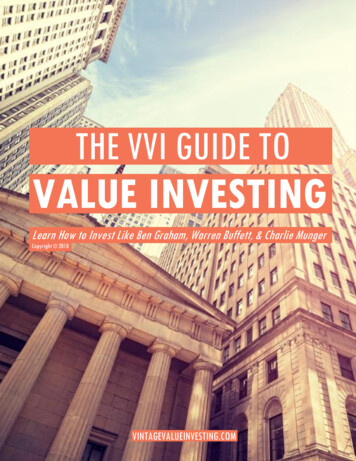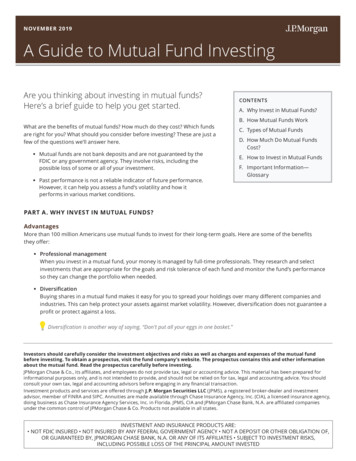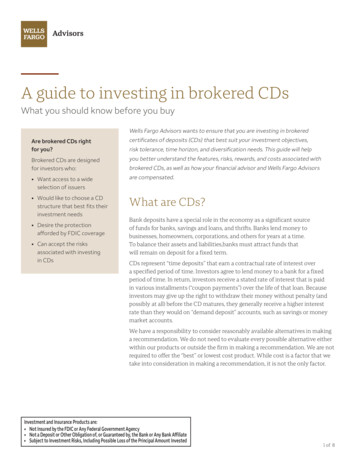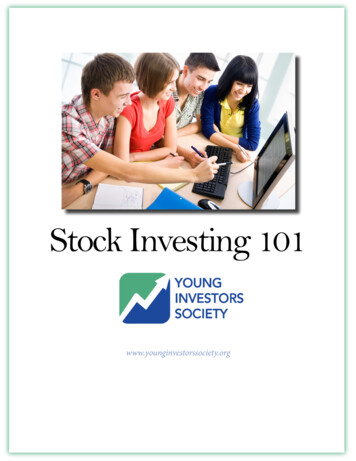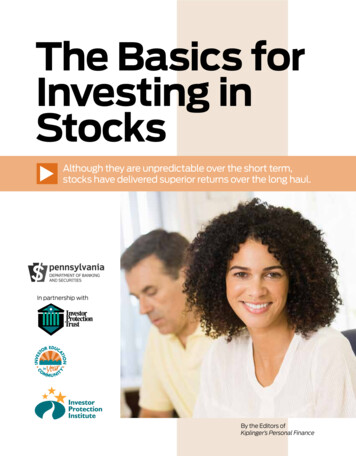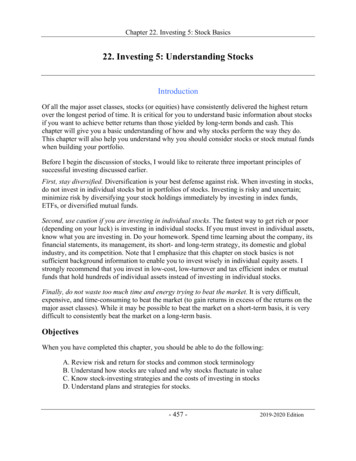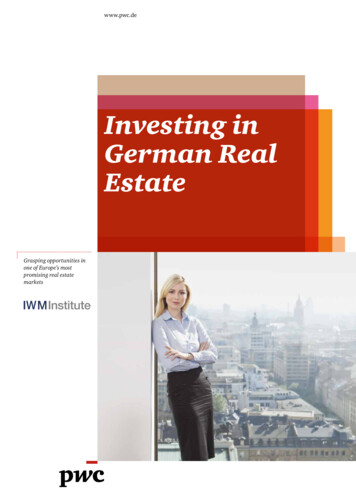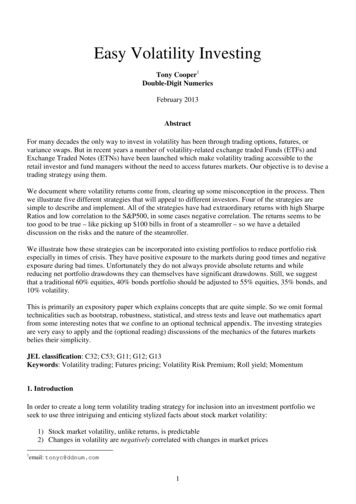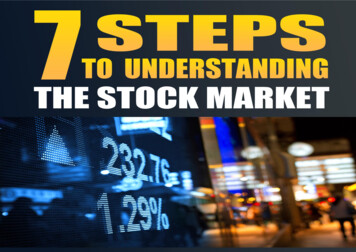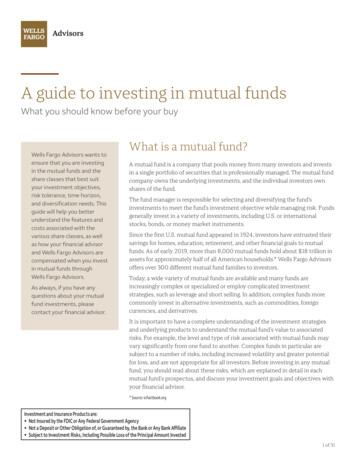
Transcription
A guide to investing in mutual fundsWhat you should know before your buyWells Fargo Advisors wants toensure that you are investingin the mutual funds and theshare classes that best suityour investment objectives,risk tolerance, time horizon,and diversification needs. Thisguide will help you betterunderstand the features andcosts associated with thevarious share classes, as wellas how your financial advisorand Wells Fargo Advisors arecompensated when you investin mutual funds throughWells Fargo Advisors.As always, if you have anyquestions about your mutualfund investments, pleasecontact your financial advisor.What is a mutual fund?A mutual fund is a company that pools money from many investors and investsin a single portfolio of securities that is professionally managed. The mutual fundcompany owns the underlying investments, and the individual investors ownshares of the fund.The fund manager is responsible for selecting and diversifying the fund’sinvestments to meet the fund’s investment objective while managing risk. Fundsgenerally invest in a variety of investments, including U.S. or internationalstocks, bonds, or money market instruments.Since the first U.S. mutual fund appeared in 1924, investors have entrusted theirsavings for homes, education, retirement, and other financial goals to mutualfunds. As of early 2019, more than 8,000 mutual funds hold about 18 trillion inassets for approximately half of all American households.* Wells Fargo Advisorsoffers over 300 different mutual fund families to investors.Today, a wide variety of mutual funds are available and many funds areincreasingly complex or specialized or employ complicated investmentstrategies, such as leverage and short selling. In addition, complex funds morecommonly invest in alternative investments, such as commodities, foreigncurrencies, and derivatives.It is important to have a complete understanding of the investment strategiesand underlying products to understand the mutual fund’s value to associatedrisks. For example, the level and type of risk associated with mutual funds mayvary significantly from one fund to another. Complex funds in particular aresubject to a number of risks, including increased volatility and greater potentialfor loss, and are not appropriate for all investors. Before investing in any mutualfund, you should read about these risks, which are explained in detail in eachmutual fund’s prospectus, and discuss your investment goals and objectives withyour financial advisor.* Source: icifactbook.orgInvestment and Insurance Products are: Not Insured by the FDIC or Any Federal Government Agency Not a Deposit or Other Obligation of, or Guaranteed by, the Bank or Any Bank Affiliate Subject to Investment Risks, Including Possible Loss of the Principal Amount Invested1 of 31
We have a responsibility to consider reasonably available alternatives in makinga recommendation. We do not need to evaluate every possible alternative eitherwithin our products or outside the firm in making a recommendation. We are notrequired to offer the “best” or lowest cost product. While cost is a factor that wetake into consideration in making a recommendation, it is not the only factor.You should consider factors such as those below prior to accepting arecommendation: The potential risks, rewards, and costs in purchasing and in the futureselling of a security. Your age, other investments, financial situation and needs, tax status,investment objectives, investment experience, investment time horizon,liquidity needs, and risk tolerance. The security’s investment objectives, characteristics (including any special orunusual features), liquidity, volatility, and likely performance in a variety ofmarket and economic conditions. For complex products, you should consider whether less complex orcostly products achieve the same objectives.By accepting a recommendation, you acknowledge that you have consideredthe above factors to your satisfaction.Types of mutual fundsMoney market mutual fundsLike all mutual funds, moneymarket funds are sold byprospectus. It is important toconsult the prospectus whenconsidering whether or not toinvest in a fund. Theprospectus containsinformation on the fund’sinvestment objectives orgoals, principal strategies forachieving those goals,principal risks of investing inthe fund, fees, charges andexpenses, past performance,and other importantinformation you should knowbefore investing.A money market mutual fund is an open-end mutual fund that is required toinvest in low-risk short-term securities, which may include municipal securities.Money market mutual funds are generally liquid due to the short-term nature oftheir underlying investments and are typically used by investors who have a lowrisk tolerance. Investors interested in a conservative alternative for theirdiscretionary money may find that money market mutual funds may allow forpreservation of capital, liquidity, and return on principal.On July 23, 2014, the Securities and Exchange Commission adoptedamendments to the rules that govern money market funds. These rules becameeffective on October 14, 2016. The amended rules are designed to reduce the riskof investor runs on money market funds in times of financial crisis and increasethe transparency of these funds to investors.A key element of the reform is the establishment of three categories of moneymarket funds: retail, government, and institutional. There are a variety of changesand distinctions within these categories, based on the type of fund, includingrestrictions on who can invest in retail money market funds and the requirementthat institutional prime (funds that invest in corporate debt) and municipalmoney market funds move from a stable 1 price per share net asset value (NAV)to a floating NAV.In addition, the reform includes provisions requiring the funds (excludinggovernment funds) to impose liquidity fees and possibly suspend or limit shareredemptions when a fund’s portfolio fails to meet certain liquidity thresholds.These new rules allow for redemption fees of up to 2% and the suspension of2 of 31
share redemptions for up to 10 business days during a 90-day period if the fund’sboard determines it is in the fund’s best interests to do so. This must be promptlyand publicly disclosed.Differences between the three types of money market fundsRetail money market funds must have policies and procedures reasonablydesigned to limit beneficial ownership to natural persons, meaning individualinvestors. The definition of natural person includes participants in certaintax-deferred accounts, such as defined contribution plans. Institutional investorscurrently in these funds will be required to exchange their shares. These fundstransact at a stable 1.00 NAV and may be subject to the imposition of amandatory or discretionary liquidity fee and redemption gate during periods ofextreme market stress if the fund’s board determines it is in the fund’s bestinterests to do so.Government money market funds are available to both retail and institutionalinvestors. These funds are required to invest at least 99.5% of their total assets incash, government securities, or cash. They trade at a stable 1.00 NAV and arenot required but have the option to, voluntarily adopt the liquidity fee/redemption gate provisions if previously disclosed to investors.Institutional prime and institutional municipal money market funds (taxexempt funds) are required to maintain a floating NAV for sales and redemptionsbased on the current market value of the securities held in the fund. Share pricesfluctuate depending on market conditions and are rounded to the fourth decimalplace ( 1.0000). These funds may have multiple intraday price times toaccommodate same day settlement. And these funds are subject to liquidity feesand the temporary suspension of withdrawals. In addition, institutional moneymarket funds no longer support certain account features, such as check writing.Risk considerations You could lose money by investing in a money market fund. Although stable value money market funds seek to preserve the value of yourinvestment at 1.00 per share, it cannot guarantee it will do so. Alternatively, because the share price of floating NAV money market fundswill fluctuate, when you sell your shares they may be worth more or less thanwhat you originally paid for them. The fund may impose a fee of up to 2% upon the sale of your shares or maytemporarily suspend your ability to sell shares if the fund’s liquidity falls belowrequired minimums because of market conditions or other factors. An investment in a money market mutual fund is not insured orguaranteed by the Federal Deposit Insurance Corporation or any othergovernment agency. The fund sponsor has no legal obligation to provide financial support tothe fund, and you should not expect that the sponsor will provide financialsupport to the fund at any time. While Money Market Funds typically maintain a stable Net Asset Value(“NAV”), some funds may choose to convert from a Stable NAV to a floatingNAV Money Market Fund.For more information, contact your financial advisor, or read A Guide to Investingin Cash Alternatives by Wells Fargo Advisors (wellsfargoadvisors.com/guides).3 of 31
Target-date mutual fundsA “target-date” mutual fund (also known as a “life-cycle” or “age-based” fund) isdesigned to provide a more simplified investment strategy through a singleinvestment. The fund manager focuses on a particular time horizon in the future(such as 2030, 2040, or 2050) and adjusts the underlying portfolio and asset mixto manage the level of risk and the volatility as the target date approaches.Target-date funds generally consist of a blend or bundle of existing mutual funds.This “fund of funds” concept may provide greater diversification, but it may do soat the cost of higher ongoing fees and expenses associated with the underlyinginvestments. Because each mutual fund manager’s approach to investmentstrategy and risk will differ, two different funds with the same targeted date mayhave noticeably different allocations and performance from each other. Thesefunds should be reviewed on a periodic basis to ensure that they remainconsistent with your overall investment objectives.Risk considerationsTarget-date funds should not be selected based solely on age or retirement date.Be sure to assess the fund details and make sure that its objectives and holdingsare consistent with your risk tolerance and objectives. Target-date funds do not provide a guaranteed return and do not guaranteeprotection of principal at any time including at its target date. Target-date funds are subject to the risks associated with the underlyingfunds in which they invest. These risks change over time as the fund’s assetallocation strategy adjusts as it approaches its target date. They may not meettheir stated investment objectives and goals, and may lose money.Fixed income mutual fundsFixed income funds, or bond funds, are a type of mutual fund that primarilyinvests in a specific type of bond, or a mix of bonds or investments, such asgovernment, municipal, convertible, and zero-coupon bonds, as well asmortgage-backed securities.Risk considerations Bond funds can lose value especially in periods of rising interest rates. Theinverse relationship (associated with traditional bond prices and yields)also applies to bond funds. When interest rates rise, the bond prices fall andcorrelated bond fund values may drop as well. The opposite is true as well; ifinterest rates and bond yields fall, then bond prices could rise. As a result, the underlying bonds held in a bond fund are subject to credit,interest rate, reinvestment, prepayment, and liquidity risks, which may bereflected in the bond funds NAV. The fees and expenses of the mutual fund can erode the interest rate and NAVof a bond fund, which reduced the return to the investor. Bond funds do not have a fixed maturity date. The lack of a fixed maturity dateand potential investors’ demands for redemption are factors that may alsohave a negative impact on the fund’s NAV and share price. The NAV of a bondfund may be affected by factors related to the underlying securities includingbut not limited to, credit quality, duration, liquidity, and security structure.4 of 31
Municipal bond fundsMunicipal bond funds are fixed income funds that invest primarily in tax-freemunicipal securities and are subject to the creditworthiness of their issuers.Although income from municipal securities is generally free from federal taxesand state taxes (for residents of the issuing state), capital gains and capital gainsdistributions, if any, will be subject to taxes. Income for some investors may alsobe subject to the federal Alternative Minimum Tax (AMT). You should not buy afixed income fund based solely on the yield. It is important to consider all risksand characteristics of a bond fund when making your investment decisions.Risk considerations Municipal bond funds are subject to the same risks as their underlyingmunicipal securities. Economic issues may impact the performance of themunicipal bond issuer. As a result, principal is at risk or subject to fluctuation.For instance, if the underlying municipality defaults or the security isdowngraded, the value of your portfolio may also decrease. Some single-state municipal bond funds may lack the diversification of a fundthat invests in multiple-state issues, such as a multi-state or national fund. Municipal bond funds often hold securities from outside their designatedcountry or state (including securities from U.S. territories, such as Puerto Rico).High yield and floating rate mutual fundsHigh yield and floating rate mutual funds are both fixed income funds that investprimarily in below investment grade securities (sometimes called junk bonds).The securities held within high yield and floating rate funds are often rated belowinvestment grade by one or more of the nationally recognized statistical ratingorganizations or may not be rated by a rating agency.These funds take on the risks of the underlying instruments held in the fundportfolio. For instance, the “floating rate” indicates that the interest rate tied tothe underlying instruments will rise and fall, or float, with the variable ratechanges and market conditions. These interest rates usually adjust every 30–90days. Investors should take interest rate spreads, credit quality, and collateral intoaccount when considering the fund’s portfolio.Risk considerations High yield and floating rate funds are considered speculative and carryincreased risks of price volatility, underlying issuer creditworthiness,illiquidity, and the possibility of default in the timely payment of interest andprincipal, which may impact the value of your portfolio. These funds do not maintain a stable NAV and should not be considered cashalternative funds. You can lose money in these funds.For more information about individual high yield bonds, please read A Guide toInvesting in High Yield Bonds by Wells Fargo Advisors (wellsfargoadvisors.com/guides). For more information about floating rate securities, please read A Guideto Investing in Floating Rate Securities by Wells Fargo Advisors(wellsfargoadvisors.com/guides).5 of 31
International fundsMutual Funds may invest in foreign securities and currencies of developed,emerging market, and frontier market countries.Risk considerations International investments (equity and fixed income) may be subject toincreased risks and could lose value as a result of political, financial, andeconomic events in foreign countries. Foreign investments typically have less publicly available informationthan U.S. investments, are subject to less stringent foreign securitiesregulations than domestic securities, and are influenced by differentfactors than in the U.S.Complex mutual fundsSome mutual funds employ complex and specialized investment strategies.These funds commonly invest in alternative investments, such as commodities,foreign currencies, and derivatives, and may employ a flexible approach to investwidely across asset classes and use complicated and aggressive investmentstrategies, such as leveraging and short selling to manage their portfolios.Risk considerations Complex funds are subject to increased volatility and greater potential for loss. The level and type of risk associated with complex mutual funds may varysignificantly from one fund to another. It is important to have a broadunderstanding of the investment strategies and underlying products fromwhich a complex mutual fund derives its value in order to evaluate its risks.Nontraditional mutual fundsNontraditional mutual funds are mutual funds that are designed to deliver amultiple of the return, or the inverse thereof, of a designated benchmark index,on a daily or monthly basis. These funds use complex, derivatives basedinvestment strategies, and their performance over time can deviate significantlyfrom the stated daily or monthly objective. Nontraditional mutual funds include: Inverse mutual funds. Inverse mutual funds seek a return that is the opposite(-1x) return of the performance of an underlying benchmark index, on a daily(or monthly) basis. This means that an inverse mutual fund seeks to provide a1% gain on return for each 1% loss in the fund’s benchmark index on a daily (ormonthly) basis. Conversely, if the benchmark index goes up 1% on a given day,the fund’s loss, in theory, would be 1% that day. Leveraged mutual funds. Leveraged mutual funds seek a return that is amultiple of the performance of an underlying benchmark index, on a daily (ormonthly) basis, usually by using a combination of individual securities, futuresand total return swaps. A leveraged mutual fund attempts to provide a returnmeasured by a positive multiple, up to three-times (3x) the performance of theindex on a daily (or monthly) basis.6 of 31
Leveraged inverse mutual funds. Leveraged inverse mutual funds, or “short”funds, seek to deliver the opposite of the return of an underlying benchmarkindex, by a multiple of greater than -1x, on a daily (or monthly) basis, usuallyby short selling or using total return swaps and/or futures contracts. The fundsmay be leveraged up to negative three-times (-3x).Risk considerationsFunds for sophisticatedinvestorsNontraditional mutualfunds are not appropriatefor all investors. They aredesigned for sophisticatedinvestors who: Understand the risksassociated with the useof leverage and othercomplex strategies Understand theconsequences associatedwith daily leveragedinvestment results Accept the risks and volatilityassociated with investing incomplex mutual funds Intend to actively monitorand manage theirinvestments on a daily basisAlthough nontraditional mutual funds are designed to correlate to the sameunderlying benchmark index as a traditional mutual fund, nontraditional mutualfunds’ investment strategies are complex and present additional risks.Nontraditional mutual funds rebalance on a daily or monthly basis, per theirrespective investment objective, and their performance over periods of timebeyond their stated reset period can vary dramatically from that investmentobjective. They typically perform as daily or monthly trading vehicles and arenot intended for investors seeking a buy-and-hold strategy, particularly involatile markets. In addition: Nontraditional mutual fund positions should be monitored closelyand frequently. The volatility of the benchmark index underlying a nontraditional mutual fundduring the holding period is a variable that affects the actual return of the fundand high volatility may result in a significant loss of principal. The use of leverage within a nontraditional mutual fund will magnify the effectof volatility, so that, for example, a 3x fund will perform worse in a volatilemarket than a 2x fund based on the same index. As a result of periodic rebalanc
market funds no longer support certain account features, such as check writing. Risk considerations You could lose money by investing in a money market fund. Although stable value money market funds seek to preserve the value of your investme


